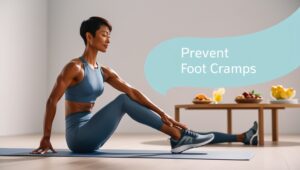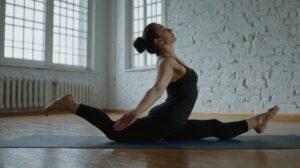Foot cramps can catch you off guard, striking without warning and causing sharp discomfort that disrupts your daily routine or a peaceful night’s sleep. These involuntary muscle contractions are not only painful but can also leave you wondering what caused them and how to prevent them from happening again.
Whether you’ve experienced a cramp due to dehydration, muscle fatigue, or standing for extended periods, the good news is that there are effective ways to relieve and prevent this common issue. In this article, we’ll explore the root causes of foot cramps and provide you with seven proven methods to address them quickly and effectively. By incorporating these tips into your routine, you can minimize the chances of foot cramps and enjoy greater comfort and mobility in your daily life.

Understanding Foot Cramps
Foot cramps are sudden, involuntary contractions or spasms of the muscles in your foot. These painful episodes can last anywhere from a few seconds to several minutes, leaving the affected muscles feeling tight and sore. While they are typically harmless, frequent or severe cramps may point to an underlying issue.
Common Causes of Foot Cramps:
- Dehydration:
- Insufficient water intake can disrupt the balance of electrolytes in your body, leading to muscle spasms.
- Muscle Fatigue:
- Overworking your foot muscles through prolonged activity or exercise can trigger cramps.
- Nutritional Deficiencies:
- A lack of essential minerals like magnesium, potassium, or calcium can impair muscle function and lead to cramps.
- Poor Circulation:
- Reduced blood flow to the foot muscles can result in cramping, especially during periods of inactivity.
- Overexertion or Standing for Long Periods:
- Excessive strain on the feet from standing or walking for extended durations increases the risk of muscle spasms.
Understanding these causes can help you identify potential triggers and take preventive measures to avoid foot cramps in the future.
Method 1: Stretching Techniques
Stretching is one of the most effective and immediate ways to relieve foot cramps. By gently elongating the muscles, you can reduce tension and improve flexibility, which helps alleviate the pain and discomfort caused by cramps.
Specific Stretches to Relieve Foot Cramps:
- Toe Flex Stretch:
- Step 1: Sit comfortably on a chair or the floor.
- Step 2: Extend the affected leg and grab your toes.
- Step 3: Gently pull your toes toward you until you feel a stretch in your arch and calf.
- Step 4: Hold the stretch for 15–30 seconds, then release. Repeat 2–3 times.
- Calf Stretch:
- Step 1: Stand facing a wall and place your hands on it for support.
- Step 2: Step one leg back, keeping it straight and the heel flat on the ground.
- Step 3: Bend your front knee slightly to feel a stretch in the calf of the back leg.
- Step 4: Hold the stretch for 20–30 seconds, then switch sides.
Regularly incorporating these stretches into your routine can help prevent future cramps by keeping your foot muscles flexible and strong.

Method 2: Massage Therapy
Massage therapy is another excellent way to alleviate foot cramps. By applying gentle pressure, you can improve blood circulation and relax tense muscles, providing quick relief.
Steps for Effective Massage:
- Hand Massage:
- Step 1: Sit in a comfortable position and place the affected foot on your opposite knee.
- Step 2: Use your fingers to knead the cramped muscle, applying gentle to moderate pressure.
- Step 3: Focus on the area where the cramp is most intense, gradually working outward in circular motions.
- Tennis Ball Massage:
- Step 1: Place a tennis ball on the floor and position your foot on top of it.
- Step 2: Apply light pressure as you roll the ball under your foot, targeting the arch and heel.
- Step 3: Continue for 1–2 minutes, focusing on sore spots.
Tips for Targeting Specific Areas:
- Use warm oil for a smoother massage and added relaxation.
- If the cramp is localized in your toes, gently pull and massage each toe individually.
Combining massage therapy with stretching can enhance relief and prevent future cramps by improving muscle elasticity and circulation.
Method 3: Heat and Cold Applications
Heat and cold therapy are simple yet powerful methods to manage foot cramps. Knowing when to use each can enhance their effectiveness.
- When to Use Heat: Heat helps relax tight and overworked muscles. Apply heat if the cramp feels persistent or caused by muscle fatigue.
- Practical examples: Use a warm towel, heating pad, or soak your foot in warm water for 10-15 minutes.
- When to Use Cold: Cold therapy reduces inflammation and numbs pain. Apply cold if the cramp is accompanied by swelling or after physical activity.
- Practical examples: Wrap an ice pack in a thin cloth and apply it to the cramped area for 10-15 minutes.
Alternate between heat and cold if needed for combined benefits.
Method 4: Staying Hydrated
Proper hydration is essential for preventing foot cramps. Dehydration can cause electrolyte imbalances, which increase the risk of muscle spasms.
- Daily Water Intake: Aim to drink at least 8-10 glasses of water daily. Adjust based on activity levels and climate.
- Electrolyte-Rich Drinks: Incorporate beverages like coconut water, sports drinks, or electrolyte tablets to replenish lost minerals such as sodium, potassium, and magnesium.
Tips for staying hydrated:
-
- Carry a reusable water bottle to sip throughout the day.
- Include hydrating foods like watermelon, cucumbers, and oranges in your diet.
- Avoid excessive caffeine or alcohol, which can dehydrate the body.
Method 5: Nutritional Adjustments
Nutrition plays a vital role in muscle health and cramp prevention. Ensuring a balanced intake of key minerals can significantly reduce the risk of foot cramps.
- Essential Minerals:
- Magnesium: Crucial for muscle relaxation and preventing spasms.
- Potassium: Helps maintain proper muscle function and prevents cramping.
- Calcium: Supports muscle contractions and overall nerve health.
- Foods to Include:
- Magnesium-Rich Foods: Spinach, almonds, and avocado.
- Potassium-Rich Foods: Bananas, sweet potatoes, and oranges.
- Calcium-Rich Foods: Dairy products, kale, and fortified plant-based milks.
- Supplements: If dietary intake is insufficient, consider magnesium or potassium supplements after consulting with a healthcare professional.
Incorporate these nutrients into daily meals to maintain optimal muscle health.

cho0sing proper foot ware Method 6: Choosing Proper Footwear
Wearing the right footwear can make a significant difference in preventing foot cramps. Poorly designed shoes can lead to strain and discomfort, increasing the likelihood of cramping.
- Supportive Shoes:
- Look for shoes with proper arch support and cushioning.
- Ensure a good fit that isn’t too tight or loose.
- Opt for breathable materials to keep feet comfortable.
- Characteristics of Good Footwear:
- Shock absorption to reduce impact on the feet.
- Flexible soles for natural movement.
- Adequate space in the toe box to prevent constriction.
- Avoid Worn-Out Shoes: Replace shoes regularly to ensure they provide sufficient support and cushioning.
Prioritize comfort and support when selecting footwear to reduce the risk of foot cramps and promote overall foot health.
- Essential Minerals:
Method 7: Regular Exercise and Preventive Stretching
which emphasizes the importance of consistent physical activity and targeted stretching to alleviate and prevent foot cramps. Here’s an explanation:
- Benefits of Strengthening and Stretching Exercises:
- Strengthening exercises improve muscle resilience, reducing the likelihood of cramps.
- Stretching maintains flexibility and relaxes tight muscles, which are often the culprits behind cramps.
- Examples of Effective Exercises:
- Yoga: Promotes overall muscle flexibility and relaxation, with poses like downward dog and child’s pose targeting the legs and feet.
- Foot-Specific Exercises: Activities such as toe curls, ankle rotations, and resistance band stretches directly strengthen and stretch the foot muscles.
- Incorporating Into a Daily Routine:
- Morning Stretches: Start the day with quick stretches to loosen muscles.
- Post-Activity Cool Down: After exercise, perform stretches to prevent stiffness.
- Daily Foot Workouts: Dedicate a few minutes to targeted foot exercises, such as picking up small objects with toes, to build muscle strength and coordination.
Practical Application:
Following this method helps to not only relieve current foot cramps but also to minimize future occurrences by ensuring the muscles remain strong, flexible, and well-prepared for physical demands
Table: Summary of Methods to Relieve and Prevent Foot Cramps
| Method | Description | Benefits |
|---|---|---|
| Stretching | Toe Flex Stretch, Calf Stretch | Improves flexibility, reduces muscle tension, immediate relief |
| Massage | Hand Massage, Tennis Ball Massage | Improves blood circulation, relaxes muscles, quick pain relief |
| Heat/Cold Therapy | Warm towels, heating pads, ice packs | Relaxes muscles (heat), reduces inflammation (cold) |
| Hydration | Water, electrolyte drinks | Replenishes fluids and electrolytes, prevents dehydration-induced cramps |
| Nutrition | Magnesium, potassium, calcium-rich foods | Supports muscle function, prevents mineral deficiencies |
| Footwear | Supportive, well-fitting shoes | Reduces strain, improves comfort, prevents cramps caused by poor shoe support |
| Exercise & Stretching | Yoga, foot-specific exercises | Strengthens muscles, maintains flexibility, prevents future cramps |
Conclusion
Foot cramps, while often inconvenient, can be effectively managed with a multi-pronged approach. By understanding the underlying causes, such as dehydration, muscle fatigue, and nutritional deficiencies, you can take proactive steps to prevent them from occurring. Incorporating stretching techniques, massage therapy, and proper hydration into your daily routine can significantly reduce the frequency and severity of foot cramps. Additionally, maintaining a balanced diet rich in essential minerals like magnesium, potassium, and calcium, along with wearing supportive footwear, further contributes to preventing these uncomfortable episodes. Remember, a combination of these methods, coupled with regular exercise and targeted stretching, will not only provide relief from current foot cramps but also establish a foundation for long-term foot health and mobility.

